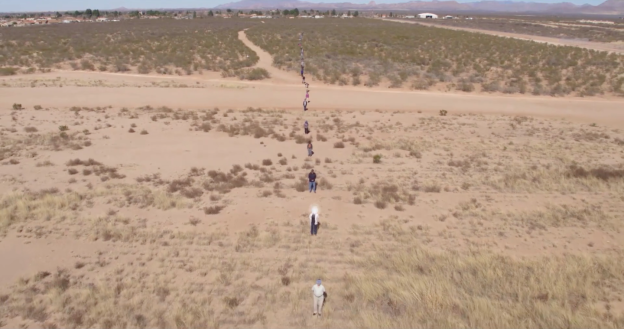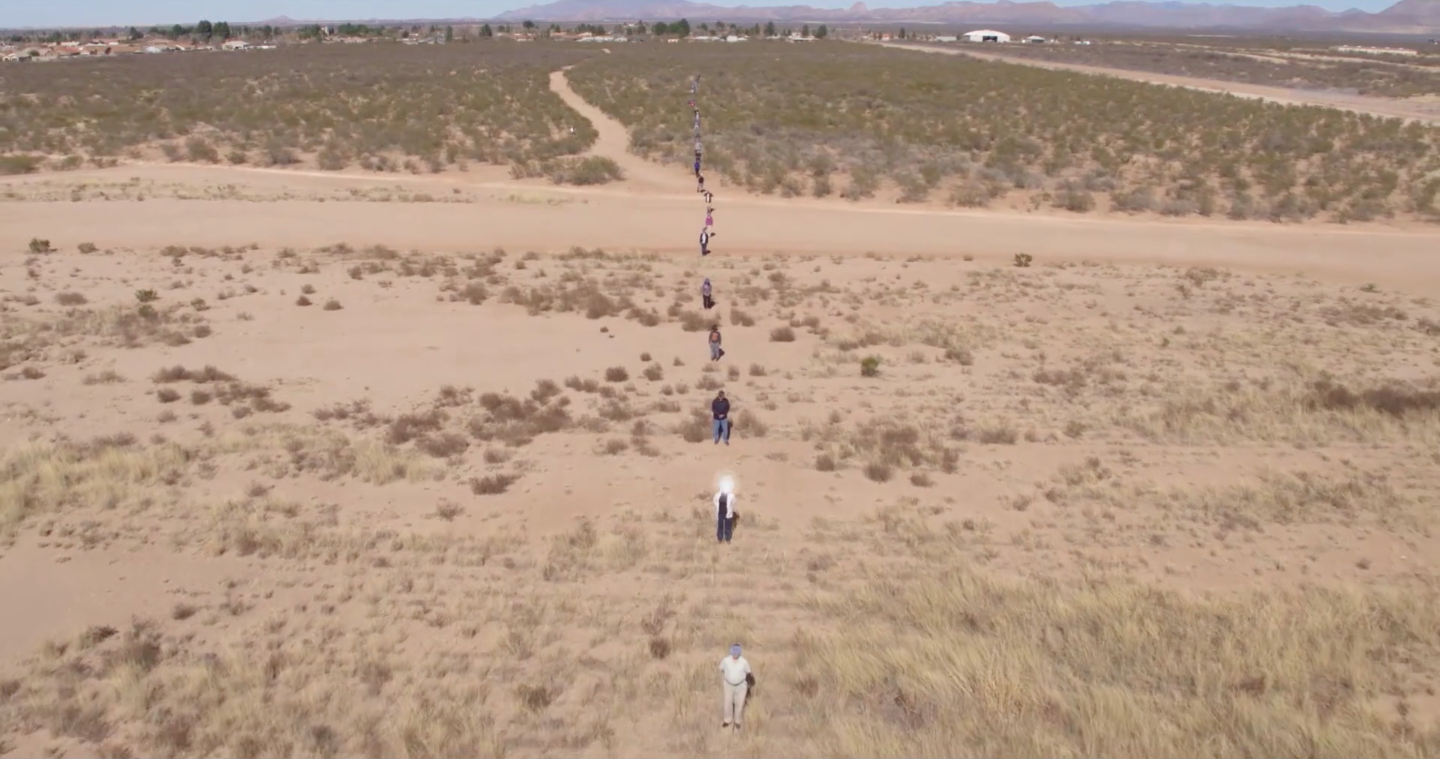
BIOPOLITICAL WARS IN THE ERA OF THE ALT-RIGHT
Word Count: 3,208 |
Download this article
by •
002: SHADOWS
with RAY OF HOPE
a video by DUNCAN McKELLAR
In a 2018 article of Current Affairs titled “The Politics of Shame,” Briahna Joy Gray[1] explains the democrats’ practice of shaming the alt-right by noting: “Trump’s policies hurt people” and, “given the easy-to-anticipate consequences of their votes, Trump voters do seem like bad people who should be ashamed. . . . [A] high level of outrage is appropriate to the circumstances. If you’re not outraged, you’re not taking seriously enough the harm done,” for instance, “to the immigrant families torn apart by ICE [Immigration and Customs Enforcement].” Whereas we are “often encouraged to engage more civilly with ‘people who disagree with us,’” what sets our current situation apart is that:
the divergent value systems reflected by America’s two major political parties cut to the core of who we are. They are not necessarily mere disagreements, but deep moral schisms. . . . Mere fact-based criticisms . . . feel inadequate, as if they trivialize the moral issues involved. It seems important to add that various beliefs, themselves, are shameful. No wonder, then, that the shared impulse isn’t just to disagree, but to “drag,” destroy, and decimate.
The current moral schism into two inimical parties indicates that today’s conflict has become properly political. Carl Schmitt is a controversial German jurist and political theorist who, although a prominent member of the Nazi party and infamous for his use of violence against Communism, has been very influential on theorists throughout the political spectrum. For Schmitt, the “criterion of the political . . . is that between friend and enemy” insofar as the concepts of “friend [and] enemy . . . refer to the real possibility of physical killing” or “war”: “the most extreme consequence of enmity.” Of course, war, as the criterion of the political, “does not have to be common . . .or desirable. But it must . . . remain a real possibility” on the horizon. In fact, a “politically reasonable course [could as well] reside in avoiding war.” “War is neither the aim nor the purpose nor even the very content of politics. But as an ever present possibility it is the leading presupposition which determines . . . human action and thinking and thereby creates a specifically political behavior.”
Furthermore, “the political can derive its energy . . . from the religious, economic, moral, and other antitheses.” Any human antithesis can “become the new substance of the political entity”—that is, the “decisive” or “sovereign” entity—if this particular antithesis becomes the “viewpoint” that decides “the friend-or-enemy grouping.” For instance, social “class…ceases to be something purely economic and becomes a political factor…when Marxists approach the class struggle seriously and treat the class adversary as a real enemy” whom they could “fight”; “were it possible to group all mankind in the proletarian and bourgeois antithesis, as friend and enemy,” the initially “purely economic” concept of class would “turn into [a] political one.”
The question, then, becomes: what is the political entity or antithesis today that makes the two major US parties enemies?
Despite her reference to Trump’s policies, Gray insists that the “feature that makes Trump unique, and the focus of . . . outrage and contempt, is not his policy prescriptions or even his several hundred thousand character failings,” but “his shamelessness.”[2] Think of Trump’s blatant nepotism, his going to the offensive upon being accused of sexual assault, his bragging about the size of his nuclear weapon’s red button, and the list goes on.[3] Trump’s uniqueness consists in his overarching strategy of not observing the established moral decorum and of exaggerating what Peter Sloterdijk defined as postmodern cynicism, namely, the attitude that, as Žižek puts it, “takes into account the particular interest behind the [professed] ideological universality.” For instance, when “confronted with . . . robbery,” postmodern cynicism responds “that legal enrichment is a lot more effective and . . . protected by the law,” as in Bertolt Brecht’s “what’s the robbery of a bank compared to the founding of a new bank?”. Accordingly, the democrats’ attempt to instigate shame in the alt-right indexes a moral condemnation of the specific kind of cynicism that acknowledges the violence and exploitation perpetrated by legitimate power—something that democratic biopower certainly wants to hide.
Relevant to the above is the democrats’ frequent comparison of Trump’s politics with fascism. Trump presents his policies as those of a sovereign rather than those of a properly biopolitical leader. Recalling Foucault, biopower operates on the principle that the function of political power is to “exert a positive influence on life,” to “optimize . . . multiply,” protect, and enhance human life as such, beyond and above any other value; it is “the power to ‘make’ live and ‘let’ die” only when death is proven to be humanly and technologically inevitable. By this token, Foucault continues, biopower is “precisely the opposite” of “sovereignty’s old right”—“the right of the sword . . . to take life or let live.” If in biopower the supreme value becomes protecting pure and simple life, then biopower cannot destroy or impede life legitimately. In Foucault’s words, given that “this technology of power . . . takes life as both its object and its objective,” the problem of biopower becomes: how to justify its sovereign “power to kill”? To which Foucault responds that biopower can legitimately designate its enemy only through a “racism” of an “evolutionist” kind. Racism being generally a “way of introducing . . . the break between what must live and what must die,” evolutionist or biopolitical racism does so through the logic that “‘the more inferior species die out . . . the more I—as a species . . . —can live, the stronger I will be” and “will be able to proliferate.’” When human life is indiscriminately deemed as sacred, then the only life that power can legitimately destroy—and, hence, legitimately declare as enemy—must not be human; it must be subhuman, belonging to an inferior species.
Indeed, as I argue elsewhere, the USA are increasingly constructing their enemies as subhuman by, for instance, presenting them as aggressors against the values that the same biopolitical discourse presents as constituting human dignity: freedom, democracy, individualism, etc. However, Trump and the alt-right do not necessarily care to construct the “enemy” as subhuman. For example, the immigrants must be banned simply in order to “make America great,” that is, explicitly for the sake of US American sovereignty. The alt-right selects its enemies according to the criteria of sovereignty which openly disregard human life as such. In other words, part of the alt-right’s shameless and shocking demeanor includes revealing what in biopower must remain hidden: its aspect as a sovereign form of power, and ultimately, as a political power tout court—since the political presupposes the friend-enemy grouping. And we know from Lacan’s equation of biopower—the “modern master”—with the “discourse of the university,” that the essence of biopower lies precisely in this denial of its political character and in presenting itself as the bearer of “objective knowledge.”
In his opposition to biopower—and, as Jacques-Alain Miller remarks, “to “globalization . . . Americanization . . . [and] utilitarianism”—Lacan invokes nothing other than shame, insofar as shame is an affect that results from the loss of one’s honor. In 1970, in his final lesson of The Other Side of Psychoanalysis, Lacan announces that “there is no longer any shame” and that to be willing to kill oneself or others out of shame is fundamentally incompatible with the biopolitical logic, since “to die of shame” presupposes that one puts honor over life as such. “The disappearance of honor” means that “we are at the time of an eclipse of the Other’s gaze as the bearer of shame”; instead, we are under the gaze of the Other of the society of the spectacle which exhorts us to “Look at them enjoying!” and to turn all “reality into a spectacle,” into a reality show, as the internet, Facebook, and “selfies” all testify today. Today, “the dominant [biopolitical] discourse enjoins one not to be ashamed of one’s jouissance.”
Drawn to its logical conclusion, the above means that in biopower, as the form of power accompanying the society of shameless jouissance, any mode of jouissance should be permitted. The same imperative—“do not be ashamed of your jouissance!”—entails as much the demand, say, to respect religious and cultural differences or to legitimize LGBT+ rights as the demand to respect, say, chauvinism, homophobia, misogynism, racism, and any other conceivable mode of jouissance. What infuriates the democrats is the fact that by now the right no longer plays according to its traditional, moralizing rules but according to the rules of the by now dominant discourse of the shameless enjoyment of one’s jouissance, which the democrats had evidently erroneously mistaken for their own exclusive prerogative.
Recapitulating, the alt-right’s outrage- and hostility-inducing effect on the democrats owes to the alt-right’s double relation to biopower: insofar as biopower governs the society of shameless jouissance, the alt-right adopts the rules of this game and flaunts its own modes of jouissance; but, insofar as biopower must hide its political nature, the alt-right breaks the rules of biopower by revealing biopower’s hidden underside.
Returning now to the alt-right’s perceived “shamelessness” in the context of its practice of postmodern cynicism, this kind of cynicism has as its corollary a shift in bourgeois morality. As Bernd Stegemann explains, unlike the bourgeois morality of Henrik Ibsen’s heroes who were
culpable for their actions and hoped that their guilt would not come to light, the bourgeois subjects of postmodernism . . . are frank about their guilt. . . . [E]veryone knows that slaves need to work for our smartphones and that our wealth is based on the exploitation of the whole world. [And] the paradox of this knowledge today is that those who most loudly acknowledge their complicity benefit most in public recognition. This paradoxical effect is only possible because the connection between culpable action and personal consequences seems to have been dissolved.
This dissolution between culpable action and personal consequences (particularly profit) leads to the new, intrinsically postmodern and specifically neoliberal, populist morality. In this morality, Stegemann continues, “people demand general values, then complain about the impossibility to follow them in their own lives and, then, demand moral recognition for their honesty” to admit that they break these values. In the face of a radical absence of personal responsibility, the sole remaining moral gesture consists in the honest acknowledgment of one’s complicity—and the more complicit one is, the more moral is one’s position. Here we see the paradox of the inversion of radical irresponsibility into its opposite, radical morality.
In a discourse for which irresponsibility is the sole remaining moral value, the political debate inevitably slides from a quest for concrete loci of responsibility to a dispute about general moral superiority. This is the reason why many, Stegemann included, consider “the language rules of political correctness,” identity politics, the entire discourse of the “biopolitical perfection of everyday life,” and “the uplifting of general morality,” as means for “robb[ing] people of the language to formulate their class interests.” According to Stegemann “promotion of subjective optimization” conceals “all systemic inequalities,” and “the compensation for economic inequality takes place in the symbolic order by promoting the individual liberties in the field of identity politics.” And by “respond[ing] with the same outrage to the moral attacks from the right,” the Left simply “remain in the Babylonian captivity of New Liberalism” and miss the chance for any effective opposition, according to Stegemann.
But the catch-22 of the democrats or the Left is that they are forced to engage in this moralization of politics and the construction of their opposition as morally inferior, because this is the sole way left to them to act politically—as long as they follow the rules of biopower. For biopower is by definition a pacifist form of power, and the construction of the enemy as subhuman is the precondition of any division between friend and enemy that a pacifist power could justifiably invoke. As Carl Schmitt discerned in 1932, the “particularly promising [besonders aussichtsreiche] way of justifying wars” today is “pacifism.” Pacifism is forced by its own logic to present its war as a “war against war,” a war to end all wars, “the absolute last war of humanity”—the further assumption here being that pacifism constitutes the highest evolutionary level in the development of human life, and that this last war aims at destroying only that life which, for whatever reason, has not obtained this level of development. That is, the pacifist war aims at destroying those lives that are willing to kill themselves and other human lives in the name of some value which for them is higher than human life pure and simple. Consequently, Schmitt continues, “such a war is necessarily unusually intense and inhuman” because it must “degrade the enemy in moral and other terms and is forced to make of him a monster that must not only be defeated but also utterly destroyed [vernichtet]” according to the logic, to repeat Foucault’s words: “‘the more inferior species die out . . . the more I—as a species . . . will be.’”[4]
The millennial reconfiguration of the moral as the political entails that the ultimate criterion for defining the enemy is the moral inferiority of not respecting human life as such. This puts in the same subhuman boat the alt-right and anybody who takes any value and antithesis (e.g., social class) seriously so as to be willing to fight. By becoming pray of the biopolitical pacifist pitfall, by forgetting that sovereignty remains the essence of the political regardless of what might come to occupy its substance, the Left lose their political thrust.
The Left, like anybody else, can amount to a political force in only one of two ways: the sovereign way or the biopolitical way. In the sovereign way, it could declare as enemy any group that impedes the sovereignty of its own social class—and, of course, the problem today is how to define the latter. In the biopolitical way, the Left can declare as its enemy only a subhuman group, which is what the invocation of shame endeavors to do.
[1] Current Affairs is self-described as a left-wing magazine edited by Harvard sociology graduate student Nathan J. Robinson. Briahna Joy Gray is current Senior Politics Editor at The Intercept, and her article “The Politics of Shame” was included in the Current Affairs’ issue on “Shame: Its Uses and Abuses.”
[2] A shamelessness that is evidently rampant, since “even when it appears as if Trump is on the verge of an apology or admission, he quickly lapses back into shamelessness.” Now, in spite of the above, Gray proceeds to respond to her own question—“How effective is shame as a tactic?”—negatively and argues against the politics of shame on the basis of strategic reasons. For, as “social science confirms . . . shaming is an ineffective strategy for motivating moral behavior.” As Gray puts it: The person experiencing shame thinks “what a horrible person I am,” and searches for a way to preserve [his or her] self-esteem… Feeling their entire self-image under attack, shame-prone individuals are more likely to externalize blame and lash out destructively, including physically and verbally… [Ultimately,] shamed individuals are prone to “turn the tables defensively” and direct their anger toward “a convenient scapegoat.” In short, Gray maintains, “in practice,” the politics of shame “is a mistake” because it is politically ineffective, in fact, counter-productive.
[3] More specifically, Gray remarks, “indifference to the environment, the human cost of a tattered social safety net, and the risks attendant to reckless nuclear threats are hardly unique aspects of Trump’s presidency: they’re the American way.” And “God knows plenty of presidents have been horrible people.” Certainly “Trump is not the first president or popular public figure to be accused of sexual assault—it’s a crowded field these days.” “But he was the first” one who, “instead of following the prescribed political ritual for making amends after being caught . . . chose to go on the offensive”; similarly, “nepotism may be as old as the Borgias, but the boldness with which Trump has appointed family members and their agents to positions of authority still manages to stun.” And, again, “while nuclear brinksmanship was a defining feature of 20th century presidencies, never before has the ‘leader of the free world’ literally bragged about the size of his big red button and attempted to fat-shame the leader of a rival nuclear power.” And the list of examples goes on.
[4] Schmitt’s criticism of the “pacifist” degradation of the enemy and his call to treat the enemy as equal form an implicit critique of the Nazi agenda to exterminate the Jews as “lice”—something that may relate to the fact that Schmitt was accused by the SS for fake anti-Semitism and for undermining Nazism’s racial theories (particularly in a series of articles published in the SS newspaper Das schwarze Korps in 1936; see also Bendersky).
Bendersky, Joseph. “The Expendable Kronjurist: Carl Schmitt and National Socialism 1933-36.” Journal of Contemporary History, vol. 14, no. 2, 1979, pp. 309-328.
Gray, Briahna Joy. “The Politics of Shame.” Current Affairs, 11 Mar. 2018, www.currentaffairs.org/2018/03/the-politics-of-shame.
Foucault, Michel. The History of Sexuality, Volume 1: An Introduction. Translated by Robert Hurley, Vintage, 1980.
—. Society Must Be Defended: Lectures at the Collège De France, 1975-76. Translated by David Macey, Picador, 2003.
Lacan, Jacques. The Other Side of Psychoanalysis: The Seminar of Jacques Lacan, Book XVII, 1969-70. Translated by Russell Grigg, Norton, 2007.
Miller, Jacques-Alain. “On Shame.” Jacques Lacan and the Other Side of Psychoanalysis: Reflections on Seminar XVII, edited by Justin Clemens and Russell Grigg, Duke UP, 2006, pp. 11-28.
Schmitt, Carl. The Concept of the Political. Translated by George Schwab, expanded ed., University of Chicago, 2007.
Stegemann, Bernd, “Der gute Mensch und seine Lügen.“ Zeit, 23 Feb. 2017, https://www.zeit.de/2017/09/populismus-eliten-gutmensch-luegen/komplettansicht. Translated by A. Kiarina Kordela, 2019.
Žižek, Slavoj. “How Did Marx Invent the Symptom?” The Sublime Object of Ideology, updated ed., Verso, 2008, pp. 1-56.
PROFESSOR A. KIARINA KORDELA writer
A. Kiarina Kordela is Professor of German Studies and Director of the Program for Critical Theory at Macalester College. She is the author of several books and articles. For details see her website.
DUNCAN McKELLAR artist
Duncan McKellar is an artist based in London. He studied BA(Hons) Fine Art at the Slade School of Fine Art 1999-2004. He has worked on projects and interventions across the UK, and his work has been featured in numerous film festivals, including the Chandler Film Festival, Arizona. In 2019, Ray of Hope was awarded winner of the Creekside Open, APT Gallery, London. His work can be found on his website or instagram.
RAY OF HOPE (2019) consists of 1km of people, each wearing a mirrored mask, lined up across the US/Mexico border – specifically Douglas, Arizona to Agua Prieta, Mexico. Made in collaboration with David Martin, and Border Arts Corridor (BAC).
© Copyright for all texts published in Stillpoint Magazine are held by the authors thereof, and for all visual artworks by the visual artists thereof, effective from the year of publication. Stillpoint Magazine holds copyright to all additional images, branding, design and supplementary texts across stillpointmag.org as well as in additional social media profiles, digital platforms and print materials. All rights reserved.



